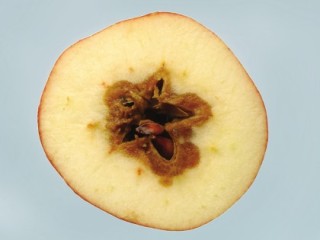
Mouldy core (Various fungi including Alternaria, Cladosporium, Epicoccum, Fusarium, Stemphylium)
Mouldy core is an internal dry rot of certain apple cultivars, especially Cameo and Bramley’s Seedling. The main problem with mouldy core is that it develops inside the apple, often in store or as the fruit ripens during marketing and can remain undetected until the fruit is eaten.
Many cultivars of apples are affected worldwide especially Red Delicious and Red Delicious types. In the UK the problem is mainly associated with the varieties Cameo and Bramley’s Seedling but is also found in Ida red, Braeburn, Gloster and certain cider apple cultivars.
Mouldy core is an internal dry rot. External symptoms are rare but fruit may colour and fall prematurely. The problem is characterised by the growth of fungus mycelium within the apple core, initially without invading the apple flesh. The fungi may invade the flesh leading to a slow, dry rot confined to the apple centre. The core rot may also continue to develop in store and may then appear at the cheek, eye or stalk end of the fruit. This is often true where the core rot is caused by Fusarium spp.
Some apple varieties, especially Bramley, can be affected by a wet core rot. This appears after harvest or post storage, usually as a soft, internal rot that eventually rots the whole fruit.
Apple varieties susceptible to mouldy core generally have an open sinus extending from the calyx into the core. Flower parts are rapidly colonised by a range of saprophytic fungi as they start to senesce and the open sinus allows these fungi to enter the core region. Wet weather during blossom encourages colonisation of flower parts by fungi and can increase the risk of mouldy core.
Mouldy core can be caused by a range of different fungi including Alternaria, Stemphylium, Cladosporium, Epicoccum and Fusarium. In an AHDB Horticulture funded study (Project TF 184), the main fungi isolated from the rotted cores of both Cameo and Bramley’s Seedling over two seasons in 2008 and 2009 were at least three different species of Fusarium, as well as Alternaria and Penicillium. In other countries Alternaria is generally the most important cause of core rots.
Wet core rots are caused by a range of fungi including Fusarium, Mucor and Penicillium. Wet core rots generally arise from fungi that enter the core when the fruit is drenched post-harvest in anti scald agents contaminated with fungal spores.
As there are generally no external symptoms, orchard monitoring to assist in decisions on fungicide timing are not practical. Wet weather during blossom encourages colonisation of flower parts by fungi and can increase the risk of mouldy core. Assessing the incidence of premature ripened fruit near harvest may give an indication of the incidence of mouldy core in the fruit.
Wet core can be solved by only drenching post-harvest if necessary and adopting strict hygiene measures in the drenching operation to prevent the build up of mud, fungal spores and other debris in the drenching solution.
Control
Overseas trials indicate that application of fungicides between first flower and petal fall will reduce the incidence of mouldy core. In AHDB Horticulture funded studies on mouldy core in the UK (Project TF 184), fungicide trials were conducted in two commercial orchards in 2008 and 2009. It was found that either sprays of Bellis (pyraclostrobin + boscalid) or Switch (cyprodinil + fludioxonil), at full bloom and 10-14 days later, had some effect in reducing mouldy core compared to where no treatments were used. The fungicides listed in the Table are likely to give some control of the problem.
On susceptible cultivars, apply a spray of one of these fungicides in blossom and repeat at petal fall.
Orchard training and pruning should allow good airflow and light penentration and allow trees to dry rapidly and reduce the risk of mouldy core. At harvest apples that are riper than usual should not be picked as these have a high chance of having mouldy core.
